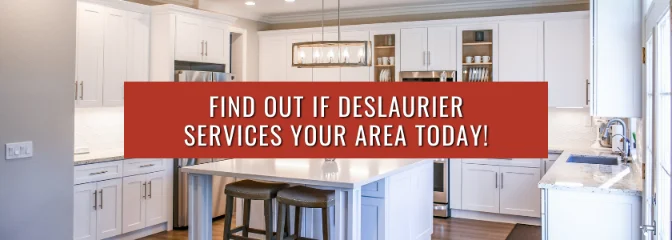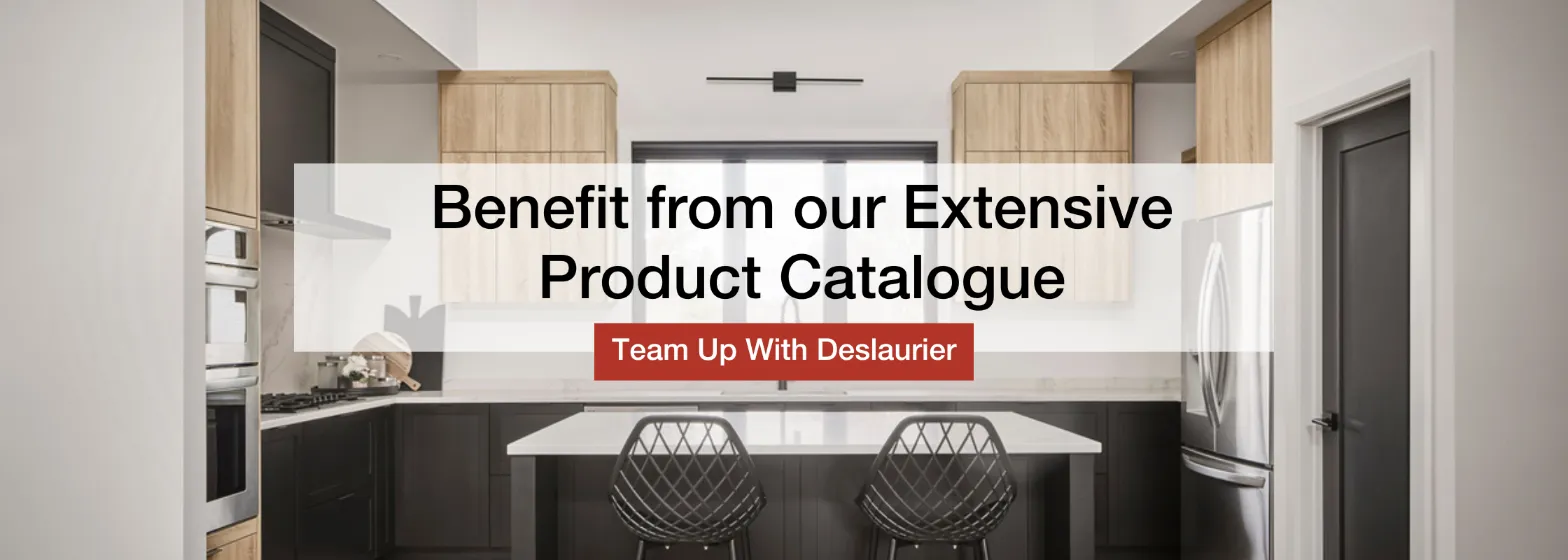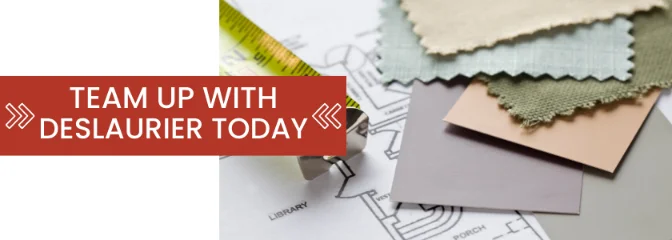16/01/2023 • Blog, Design Tips
Wood Species & Cabinet Materials at Deslaurier
Estimated Read Time: 9 Minutes
When looking for new kitchen cabinets, the number of wood species to choose from can seem overwhelming. Not to mention sifting through the man-made cabinet materials available.
We’re here to help!
At Deslaurier, for over 40 years we’ve specialized in manufacturing custom cabinets. In that time, we’ve completed thousands of projects and worked extensively with clients to select the best cabinet material for their kitchen, whether that be a wood species or an alternative product.
In this article, we’ll take a look at 13 popular wood species and engineered materials used for kitchen cabinets, from birch to thermofoil, and everywhere in between!
Let’s get to it!
|
Table of Contents |
Cabinet Wood Species
Birch
Birch has a pale colouring that can look slightly yellow-ish. It has a simple, rather open grain that is typically made up of straight (ish) lines. Birch is also one of the few woods that actually develops colour with age, gaining a yellowish-red tint as time passes.
Birch is considered a paint-grade wood thanks to its low-key grain and uniform surface. If you’re going with natural wood for your painted cabinets, birch is about as good as it gets.
It’s worth noting that birch is a slightly porous wood species. When it comes to using a dark stain on birch, it’s possible that the cabinet doors will absorb the stain at varying speeds that can cause a “blotchiness” effect. Because of that, specific areas of grain pattern may be highlighted randomly with dark stains.
Maple
A classic Canadian hardwood, maple is one of the most popular woods for kitchen cabinets. It also shares plenty of similarities with birch, like a smooth surface and similar grain patterning.
Maple’s grain pattern is generally quite straight, with some subtle waves and curls mixed in, while its colour is rooted in a gentle white with reddish-brown hues.
Thanks to those similar birch-like physical qualities, maple is also considered a paint-grade wood. However, compared to birch, maple is a less porous wood. In that sense, you shouldn’t worry about pronounced blotchiness when a dark stain is adhered to maple cabinets.
(Red) Oak
Red oak (commonly referred to simply as “oak”) is noted for having light to middle brown colouring with a cast of reddish hues, complemented by a prominent, fairly straight grain pattern.
The beauty of red oak and its prominent grain is that it can be adorned with anything from a clear coat finish to a dark stain. Although not done very often, red oak cabinets can also be painted – producing a nice, textured surface you won’t find on many other painted cabinets.
While oak often has the connotation of being a more traditional-looking cabinet wood, there are plenty of ways you can put a modern flair on oak cabinets!
Rift-Cut White Oak
Although white and red oak are from the wood family and share similar qualities, they are technically two different wood species. White oak is overall much lighter than red oak – though it still carries slight pink hues – and has a smoother surface.
When talking about white oak, it’s important to mention the popular rift-cut variety, which is what we carry at Deslaurier.
Rift-sawing wood is purely aesthetic and achieves a straight grain pattern that cuts down on shiny spots in the grain known as flakes. It is most commonly used with oak because its wood grain is generally the straightest and free from cathedrals or variations.
White oak is never painted and is almost exclusively accompanied by subtle, gentle stains. This ensures that the light, natural colouring it’s known for will emerge triumphantly and remain prominently on display.
Cherry
Cherry wood is prized for its aesthetic and is often associated with more of a traditional look. Noted for its rich, dark, reddish-brown colour and smooth, closed-grain pattern, cherry is one of the most luxurious woods you can find for your kitchen cabinets.
A key characteristic to note about cherry wood is its natural aging process. Starting almost as a light or golden pink, cherry gradually gains deep, alluring reddish-brown hues as it is exposed to oxidation and natural lighting over time.
What might be surprising about a wood-like cherry is that you’re actually less likely to apply a deep stain to them as you would with a wood-like maple. Since the wood naturally gets darker with time, it doesn’t require a deep, heavy stain like some other woods might.
Rather, thanks in part to cherry’s aging process, most people use a clear coat finish to enhance the rich, natural colour and grain pattern of cherry wood.
Walnut
Walnut is a stunning natural wood noted for its significant colour and strong, typically straight grain variation. Though its grain is very open and slightly more coarse than the smoothness of cherry, walnut still has a beautiful, uniform surface.
Walnut can range anywhere from a light brown to a deep, dark chocolate hue. In addition, it also has a unique aging process. With time, the dark brown colour of walnut naturally begins to lighten.
The qualities of walnut lend themself beautifully to light stains and clear coat finishes. When finished with a clear top coat, walnut portrays a very rich and velvety sheen that accentuates its strong grain pattern.
Rustic Alder
Rustic Alder is considered one of the “softest” hardwoods available and, as its name suggests, leans towards a more rustic aesthetic.
Rustic alder has a light base colour with yellow to peach hues. Further, It is prized for having plenty of large knots. The look and amount of knots will really fluctuate from door to door or slab to slab, which gives alder a very defined visual appeal that is great for cottagey, rustic, or farmhouse-style kitchens.
The softness of alder increases its rustic properties over time. Slight dents and scratches can almost be welcomed as worn and distressed blemishes, adding to the natural qualities of the wood. Unlike most other wood species, when it comes to rustic alder you’re actually paying “for” the defects of the wood to be present.
While darker stains are still appropriate for rustic alder, the wood is prized for its natural appearance and you’ll want to display it as much as possible. With that in mind, traditional glazes are the perfect finish for alder, as they add to the rustic appearance of the wood.
Painted MDF Cabinets
The gold standard for painted cabinets, medium density fiberboard (MDF) is a material manufactured by breaking down softwood and hardwood residuals into wood fibers.
These wood fibers are compacted with wax and resins, formed into panels, and applied with high pressure and temperatures in order to create a durable, condensed board that lends itself perfectly to painted cabinets for a number of reasons.
Firstly, MDF is free of any knots, blemishes, or tactile wood grain that is commonplace for natural woods. Its engineered surface offers a pristine canvas for the paint to adhere to.
Furthermore, MDF is the most stable “wood” product available. Since it is not solid wood, MDF is much less susceptible to “breathing,” meaning its painted finish is not as likely to expand and contract due to changes in temperature or humidity.
Engineered Kitchen Cabinet Materials
At Deslaurier, our cabinet selection isn’t restricted to natural woods. We also carry a handful of high-quality engineered cabinet materials, many of which fit perfectly in a modern-style kitchen design.
Thermofoil Cabinets
Thermofoil kitchen cabinets are a PVC vinyl material that is applied to MDF doors through heat and vacuum pressure, fusing the two together. The thermofoil process produces a seamless surface, typically in a solid colour, but sometimes also a faux wood grain pattern.
Thermofoil is an extremely popular cabinet material, as their matte and high-gloss options can replicate a painted aesthetic at a cheaper price point.
Thermofoil cabinets also withstand daily use and general household damage better than painted cabinets, making their combination of durability and appearance a perfect match for modern-style cabinets.
Thermofoil only comes in 1-piece doors, as opposed to 5-piece options available in natural wood or painted MDF. While slab (flat) doors are a popular choice, there are various detailed profiles that are available in thermofoil.
It should be noted in order to apply the thermofoil finish to a cabinet door, there needs to be a radius. Since this radius is required, the edges and corners of the detail on thermofoil doors will be rounded and won’t be as sharp as most other cabinet materials.
Thermofoil has cabinet options for almost every price range, and their standard products are typically much more cost-effective than painted MDF — making them a great budget-friendly material.
PET (Polyethylene Terephthalate)
Polyethylene Terephthalate (PET) is a thermoplastic polymer, laminated to an MDF substrate (with a proprietary glue) under high heat and pressure. While it sounds confusing, it is essentially plastic. In fact, it’s most commonly used for water bottles and soft drink bottles.
Thanks to the nature of the material, PET is easily recycled at all stages of manufacturing, making them one of the most environmentally-friendly cabinet materials you can find.
PET and thermofoil are similar materials, but they do have several key differences. Unlike thermofoil – which is a material applied onto an underlying substrate – PET is manufactured as its own sheets. This allows PET cabinet doors to be the same material on all 6 sides, with edge-banding (exposed edges of raw material are wrapped with PET) done to unify each door.
PET cabinets are prized for their matte finish and are popularly selected in solid colours. Unlike thermofoil, which can be adhered to different door styles, PET is much harder to mould onto a 3-dimensional door – and as a result – is typically found only in a flat panel cabinet door.
Further, PET is a much thicker laminate than thermofoil, giving it an impressively durable quality. It is more scratch resistant and durable and is not vulnerable to heat or moisture.
Acrylic
Acrylic is a high-quality synthetic material that provides a smooth and glossy-looking cabinet door. If you’re after a high-gloss cabinet aesthetic, acrylic is your best option.
Acrylic cabinets are popularly utilized with solid colours, especially for high-gloss products. However, depending on the manufacturer, you will be able to find acrylic cabinets in other various patterns.
What makes acrylic such a perfect material for high-gloss cabinets is its durability. A high-gloss door will always show damage more than something with a matte finish. High-gloss will essentially show everything—there’s really no hiding any scratches.
Acrylic’s impressive scratch resistance (it’s even better than PET) is the best way to reduce the likelihood of noticeable damage on a vulnerable high-gloss finish. Even more, unlike PET and thermofoil, acrylic cabinet doors can actually be repaired for scratches!
It should be noted that acrylic cabinets will only come in flat (slab) panel door styles. Their manufacturing process does not lend itself well to 3-dimensional door moulding, so acrylic will leave you limited to a slab door cabinet.
Textured Melamine
Textured melamine boards consist of a strong, raw particleboard substrate with resin-infused decorative paper permanently fused to both sides under immense heat and pressure. They are designed to reproduce the look and feel of realistic paint, wood grain, and even metal cabinets.
Melamine cabinets will actually produce a more uniform and consistent wood grain appearance than a natural wood species.
This is possible because hardwoods are natural materials and in turn, no two cabinets will have the exact same grain patterns. Thanks to melamine cabinets’ unique manufacturing process, they’re able to produce a perfectly constant grain pattern across your entire cabinetry order.
There’s even a more high-end product in European Textured Melamine (ETM).
European textured melamine is considered a higher quality, luxury line of melamine. ETM produces a prestige material with deeper textures and colours, a more realistic-looking wood grain that even feels more like natural hardwood!
Modern melamines offer a quality and high-performance solution that meets the aesthetic demands of contemporary design with a simple, slab-style cabinet door.
Metal Frame Cabinet Doors
Aluminum metal framed cabinet doors are a contemporary material that is solely unique compared to other cabinet options. Further, it is a match made in heaven for glass door display cabinets.
It is a durable material that doesn’t scratch too easily—especially on something like a matte black finish. You also don’t need to worry about moisture, heat, or humidity.
Metal cabinet doors aren’t the most flexible when it comes to design styles. They are only available as flat doors with no design or routering. Their colours are also extremely limited – most manufacturers will only carry a variety of black, grey, and stainless steel – with black being far and away the most popular.
However, where they do have the opportunity to get creative is with the variety of glass inserts available. There’s standard, leaded (crystal), acid wash, mirror, or frosted glass, and even jet black, to name a few. You can even go glassless and have the metal frames on their own.
Expect to pay a premium price for metal cabinets; although it isn’t so much the material that is expensive as it is the additional costs involved in a metal cabinet.
You’ll want to finish the interior of the cabinet, which doesn’t come cheap; there are glass inserts (if you opt for them); and there’s also the cost of interior lighting.
Design with Deslaurier Custom Cabinets
If you’re looking for the perfect custom cabinets for your kitchen, Deslaurier Custom Cabinets has everything you need!
Deslaurier proudly carries every material listed above in our product catalogue, and we believe we have a cabinet selection that will fit any budget and design style!
Book a consultation today with a Deslaurier design expert at our Jupiter, Florida Showroom or schedule a virtual meeting!
With over 40 years of experience to our name, we provide our clients with a fully customized design process with our talented team of designers.
Interested in becoming an authorized Deslaurier dealer? Visit our Become a Dealer page to learn more! Live outside the area? Visit our Find a Dealer page to connect with a Deslaurier dealer near you!


